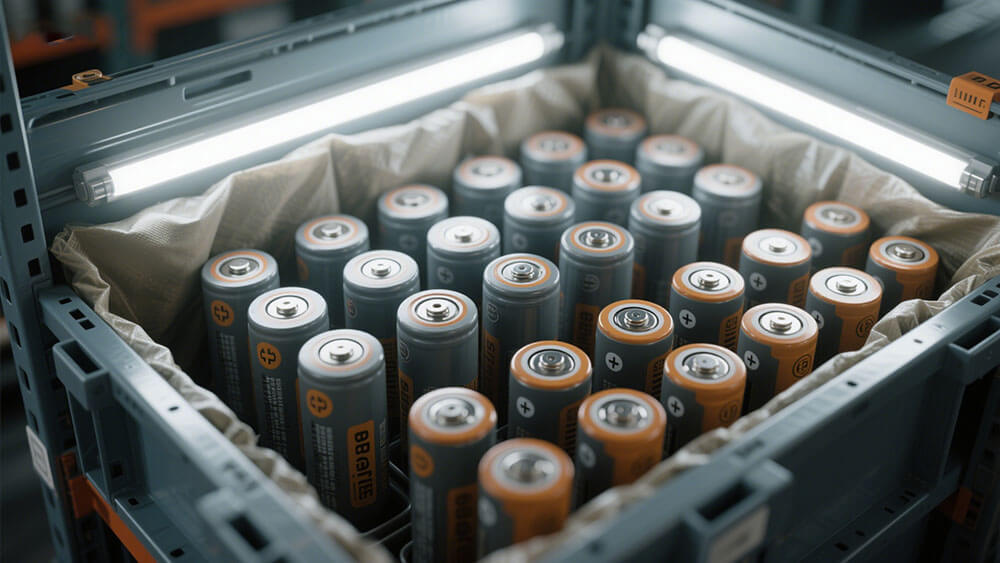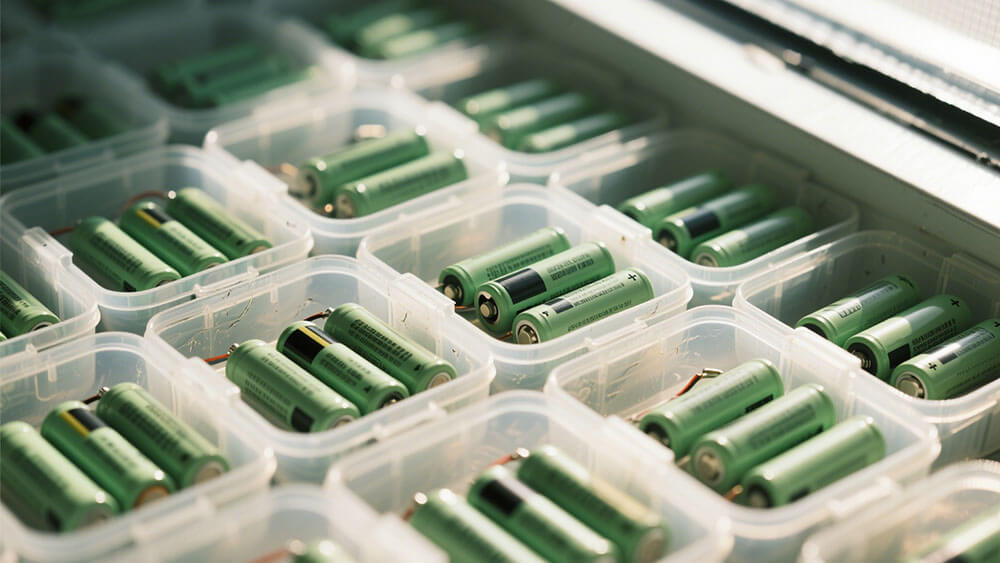
Lithium-ion cells are essential in shaping battery performance, with their size playing a pivotal role in determining energy density, life cycle, and charge/discharge rates. For example, lithium titanate cells can endure up to 10,000 cycles, whereas lithium iron phosphate cells typically last around 2,000 cycles. The size of lithium-ion cells also impacts usability, influencing compatibility with industrial applications, safety features, and maintenance needs. Selecting the right size is crucial for achieving optimal battery scalability and efficiency. Dive into lithium ion cell sizes—a comprehensive guide—to discover how they can revolutionize your designs for industrial or commercial applications.
Learn more about lithium-ion batteries.
Key Takeaways
Lithium-ion cell size changes energy storage, lifespan, and charging speed. Pick the right size for best results.
Cylindrical cells last long and are cheap, while prismatic cells save space. Pouch cells bend easily but need careful planning.
Check your device’s energy and power needs to pick the right cell size. Asking experts can improve fit and performance.
Part 1: Lithium Ion Cell Sizes – A Comprehensive Guide

1.1 Common Formats: Cylindrical, Prismatic, and Pouch Cells
Lithium-ion cells come in three primary formats, each tailored to specific applications and performance needs:
Cylindrical Cells: These cells are widely recognized for their high specific energy and mechanical stability. Their standardized sizes, such as 18650 and 21700, make them ideal for automated manufacturing processes. Cylindrical cells also feature built-in safety mechanisms and a long calendar life, though their packaging density is lower compared to other formats.
Prismatic Cells: Encased in rigid materials, prismatic cells offer excellent space efficiency, making them suitable for electric powertrains in vehicles like those produced by BMW and Audi. However, their manufacturing costs are higher due to the complexity of their design.
Pouch Cells: Lightweight and flexible, pouch cells enable creative battery layouts that enhance energy density and reduce weight. However, they are sensitive to environmental factors like humidity and temperature, requiring careful design to prevent issues such as swelling or delamination.
1.2 Standard Dimensions and Variants
Lithium-ion cells are available in various standardized dimensions and capacities, catering to diverse industrial and commercial applications. Below is a table summarizing key formats:
Cell Format | Dimensions (mm) | Capacity (Ah) | Chemistry Types |
|---|---|---|---|
Cylindrical | 18650 (18×65) | Up to 3.8 | LFP, NMC |
21700 (21×70) | Up to 5.8 | LFP, NMC | |
26650 (26×65) | Up to 5.5 | LFP, NMC | |
Prismatic | 148mm width | 100-280 | LFP, NMC |
Lithium-Polymer | Custom Footprints | Varies | Various Chemistries |
Cylindrical cells dominate applications requiring durability and cost-effectiveness, while prismatic cells excel in space-constrained designs. Lithium-polymer cells, also known as single-layer pouch cells, offer unmatched flexibility in form factor, making them ideal for custom battery solutions.
1.3 Key Differences Between Formats
Understanding the differences between cylindrical, prismatic, and pouch cells is crucial for optimizing battery pack design:
Cell Format | Performance Characteristics | Degradation Mechanisms | Manufacturing Considerations |
|---|---|---|---|
Cylindrical Cells | High thermal mass, long life | Mechanical processes, leading to particle isolation | Cost-effective, suitable for mass production |
Prismatic Cells | Space-efficient, stable | Varies, requires further study | Higher costs, scalability challenges |
Pouch Cells | Lightweight, flexible | Swelling and delamination due to environmental factors | Complex design, sensitive to external conditions |
Cylindrical cells are preferred for their robustness and ease of manufacturing. Prismatic cells balance performance and space efficiency but face scalability issues. Stacked pouch cells, a variant of pouch cells, offer higher energy density but require meticulous design to mitigate degradation risks.
Tip: Selecting the right cell format depends on your application’s priorities, whether it’s energy density, cost, or space efficiency. For custom battery solutions tailored to your needs, explore Large Power’s offerings.
Part 2: How Lithium-Ion Cell Sizes Affect Cell Performance

2.1 Energy Density: Storage Capacity Across Sizes
The size of lithium-ion cells directly influences their energy density, which determines how much energy they can store relative to their weight or volume. Larger cells, such as the 21700 format, typically offer higher capacity due to their increased internal volume. However, this comes at the cost of reduced flexibility in design and potential challenges in thermal management. Smaller cells, like the 18650, provide more modularity, allowing you to design battery packs with greater precision for specific applications.
A statistical analysis of 5,473 fresh lithium-ion cells revealed that variations in cell size significantly impact energy density outcomes. The study examined the relationship between capacity and weight, as well as capacity and resistance, highlighting the importance of cell-to-cell variations (CtCV) in determining performance metrics. These findings underscore the need to carefully select cell sizes based on your application’s energy storage requirements.
For example, cylindrical cells like the 21700 format are widely used in electric vehicles due to their balance of energy density and durability. In contrast, pouch cells, with their customizable form factors, are preferred in consumer electronics where maximizing energy density in a compact space is critical.
Tip: When designing battery packs, consider the trade-offs between energy density and other factors like thermal management and mechanical stability. This ensures optimal performance for your specific use case.
2.2 Charge/Discharge Rates: Efficiency and Thermal Management
The charge and discharge rates of lithium-ion cells depend heavily on their size and internal structure. Smaller cells generally exhibit better thermal properties, allowing for faster charge and discharge rates without overheating. Larger cells, while offering higher capacity, may face challenges in dissipating heat effectively, which can impact their efficiency and long-term cycling performance.
For instance, the discharge capacity of a cell decreases as its temperature rises during high-rate discharges. This is particularly evident in larger formats like prismatic cells, which have a lower surface-area-to-volume ratio, making heat dissipation less efficient. On the other hand, cylindrical cells, with their uniform design, manage heat more effectively, enabling higher discharge rates.
Thermal management becomes even more critical in applications requiring high power output, such as industrial machinery or robotics. Properly designed cooling systems and advanced materials can mitigate these challenges, ensuring consistent electrochemical performance and extending the cycle life of the cells.
Note: Always evaluate the thermal properties of the cells you choose. Effective thermal management not only enhances efficiency but also prevents safety risks like thermal runaway.
2.3 Implications for Battery Pack Design and Scalability
The size of lithium-ion cells plays a pivotal role in determining the scalability of battery packs. Larger cells, such as the cylindrical 4680 format, simplify pack assembly by reducing the number of cells required. This can lower production costs and improve energy density at the pack level. However, these benefits come with challenges in thermal management and mechanical stability.
A case study comparing prismatic hard case cells (PHEV2) and cylindrical 4680 cells highlights these trade-offs. While prismatic cells offer excellent space efficiency, their complex production processes and higher costs can limit scalability. Cylindrical cells, on the other hand, benefit from well-established manufacturing techniques, making them more suitable for large-scale applications like electric vehicles and grid storage.
For commercial applications, scalability often depends on balancing performance, cost, and design flexibility. Modular designs using smaller cells, such as the 18650 format, allow for easier maintenance and replacement, making them ideal for industrial and medical applications. Larger cells, while less modular, can reduce the overall complexity of the battery pack, which is advantageous for high-capacity systems.
Callout: If you’re designing a battery pack for industrial or commercial use, consider consulting with experts to optimize scalability and performance. Explore custom battery solutions tailored to your needs.
Part 3: Usability Factors in Lithium-Ion Cell Sizes

3.1 Compatibility with Industrial and Commercial Applications
Lithium-ion cells play a critical role in powering a wide range of industrial and commercial applications. Their size directly impacts compatibility with specific systems, influencing factors such as energy density, modularity, and scalability. For industrial applications, such as robotics or heavy machinery, larger cells like the 21700 or 4680 formats offer higher capacities and simplified assembly processes. These cells reduce the number of units required in a battery pack, streamlining integration and lowering production costs.
In contrast, commercial applications, including consumer electronics and medical devices, often prioritize compact designs. Smaller cells, such as the 18650 format or pouch cells, provide the flexibility needed to create lightweight and space-efficient battery packs. This adaptability ensures that lithium-ion cells meet the diverse requirements of industries ranging from infrastructure to security systems.
Tip: When selecting a cell size, evaluate the specific energy and power demands of your application. Consulting with experts can help you optimize compatibility and performance. Explore custom battery solutions tailored to your needs.
3.2 Safety Considerations: Thermal Runaway and Protection Mechanisms
Safety remains a top priority when designing lithium-ion battery packs. The risk of thermal runaway—a chain reaction caused by overheating—varies across cell sizes and formats. Larger cells, such as prismatic or cylindrical 4680 cells, have a lower surface-area-to-volume ratio, making heat dissipation more challenging. This increases the likelihood of localized overheating if proper thermal management systems are not in place.
A safety analysis revealed that lithium-ion batteries have a failure rate of one in 200,000. Despite this low rate, recalls have occurred due to safety concerns. Thermal runaway often results from microscopic metal particles causing short circuits, leading to elevated temperatures and potential cell disintegration. To mitigate these risks, manufacturers incorporate safety mechanisms such as:
Limiting active material to reduce the energy released during a failure.
Adding internal safety features like pressure relief valves and separators.
Using electronic protection circuits to prevent overcharging and overheating.
Experimental data further validates these measures. For example, nail penetration and impact tests on various cell types demonstrate how safety protocols minimize ignition risks.
Test Type | Cell Type | Cell Capacity | Speed/Height | Measurement Method |
|---|---|---|---|---|
Needle Penetration Test | Mono Cells | 50 mAh | 0.02 mm/s | Voltage and temperature recorded simultaneously |
Nail Penetration Test | Stacked Cells | 3500 mAh | 150 mm/s | Voltage and temperature recorded simultaneously |
Impact Test | Pouch Cells | 3500 mAh | 61 cm height drop | Voltage, surface temperature, and video recording of ignition status |
Note: Implementing robust thermal management systems and adhering to safety standards can significantly reduce the risk of thermal runaway.
3.3 Maintenance and Replacement in Battery Packs
The maintenance and replacement requirements of lithium-ion cells depend on their size and application. Smaller cells, such as the 18650 format, offer modularity, making them easier to replace individually. This feature is particularly beneficial for industrial and medical applications, where minimizing downtime is critical. Larger cells, while less modular, reduce the overall complexity of the battery pack, simplifying maintenance in high-capacity systems.
Lithium-ion batteries require less frequent maintenance compared to traditional lead-acid batteries. Key advantages include:
Remote monitoring capabilities through Battery Management Systems (BMS).
Condition-based maintenance that predicts degradation and prevents sudden capacity drops.
Minimal need for terminal retightening, unlike lead-acid batteries.
Empirical evidence supports the long-term performance of lithium-ion cells. Over 3 billion data points from 228 commercial NMC lithium-ion cells reveal predictable capacity and impedance fade over time. This data helps optimize maintenance schedules and extend battery life.
Metric | Description |
|---|---|
Data Points | Over 3 billion data points from 228 commercial NMC/C-SiO lithium-ion cells |
Aging Duration | Cells aged for more than a year under various operating conditions |
Measurements | Capacity and impedance fade measurements |
Applications | Modeling battery degradation, optimizing operating strategies, and testing algorithms |
Callout: Proper maintenance protocols, provided by the battery integrator, ensure the longevity and reliability of lithium-ion battery packs. For custom solutions, visit Large Power.
Part 4: Practical Recommendations for Choosing the Right Lithium-Ion Cell Size

4.1 Application-Specific Needs: Industrial vs. Commercial Use Cases
Choosing the right lithium-ion cell size depends heavily on your application. Industrial applications, such as robotics or heavy machinery, often require larger cells like the 21700 or 4680 formats. These cells provide higher capacities and simplify battery pack assembly by reducing the number of units needed. This approach enhances scalability and lowers production costs. For example, in robotics, larger cells can support extended runtimes and high power outputs, critical for demanding tasks. Learn more about robotics applications.
In contrast, commercial applications, including consumer electronics and medical devices, prioritize compact and lightweight designs. Smaller cells, such as the 18650 format or pouch cells, offer the flexibility needed to create space-efficient battery packs. This adaptability ensures compatibility with devices where portability and energy density are key. For instance, in medical devices, smaller cells allow for ergonomic designs without compromising performance. Explore medical battery solutions.
Tip: Evaluate your application’s energy and power demands carefully. Consulting with experts can help you select the optimal cell size for your specific use case.
4.2 Best Practices for Battery Pack Design and Optimization
Designing an efficient battery pack requires balancing energy density, thermal management, and scalability. Following established guidelines ensures optimal performance and longevity.
Metric | Description |
|---|---|
Wh/kg | Pack Gravimetric Energy Density |
Cell to Pack mass ratio | Ratio of the mass of the cell to the mass of the entire battery pack design |
Smaller cells, like the 18650, allow for modular designs, making maintenance and replacement easier. Larger cells, such as the 4680, reduce complexity by minimizing the number of cells in the pack. However, they require advanced thermal management systems to prevent overheating.
Note: Incorporate a robust Battery Management System (BMS) to monitor cell health and prevent issues like overcharging or thermal runaway. This step is critical for ensuring safety and reliability.
4.3 Emerging Trends in Lithium-Ion Cell Size Development
The lithium-ion industry is evolving rapidly, driven by technological advancements and market demands. Key trends include:
Diversification of anode materials, with silicon emerging as a high-performance alternative to graphite. This innovation could significantly increase energy capacity.
Development of larger cells to enhance energy storage, particularly for electric vehicles requiring longer runtimes and faster charging.
Adoption of cell-to-pack configurations by companies like Tesla and CATL, which optimize energy density by eliminating intermediate modules.
Forecasts predict the global lithium-ion battery market will exceed $400 billion by 2035, fueled by the growing demand for electric vehicles. Innovations in cell design, such as silicon and lithium-metal anodes, promise up to a 50% increase in energy density. However, challenges like cycle life and material longevity remain barriers to widespread adoption.
Callout: Stay ahead of the curve by exploring custom battery solutions tailored to your needs. Consult with Large Power experts.
Lithium-ion cell sizes significantly influence performance metrics like energy density and usability factors such as compatibility and safety. Selecting the right cell size ensures optimal scalability for industrial and commercial applications. Innovations like cell-to-pack assembly enhance energy density and efficiency, driving advancements in battery pack design. Explore custom solutions to optimize your designs.
FAQ
What is the most common lithium-ion cell size for industrial applications?
The 21700 format is widely used in industrial applications due to its high capacity and scalability. Learn more about industrial applications.
How does cell size affect battery pack maintenance?
Smaller cells, like 18650, allow modular replacements, simplifying maintenance. Larger cells reduce complexity but require advanced thermal management systems for reliability.
Why is thermal management critical for larger lithium-ion cells?
Larger cells, such as prismatic formats, dissipate heat less efficiently, increasing the risk of overheating. Proper thermal management ensures safety and extends battery life.
Tip: For custom battery solutions tailored to your needs, consult Large Power experts.






